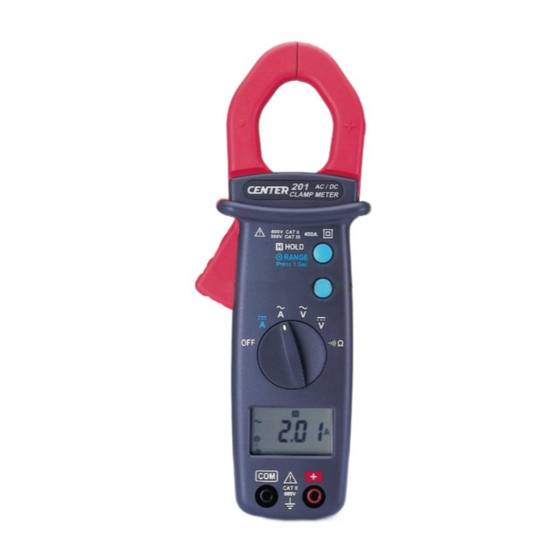
Table of Contents
Advertisement
Quick Links
Advertisement
Table of Contents

Summary of Contents for Center 201
- Page 1 METER MINI AC/DC CLAMP...
-
Page 2: Table Of Contents
CONTENTS TITLE PAGE I. Safety Information …………………………… 1 Environmental Conditions……………………………. Explanation of Symbols……………….………………. II. Specification ……………………………………… General Specification…………………………………… 2 Electrical Specification…………………………………. 3 III. Instrument Familiarization ……………... 4 Symbol Definition………………………………………...4 Button instruction……………………………………….. 5 IV. Measuring Instruction ……………...……... 6 4.1 AC Current Measurement………………………...……… 4.2 DC Current Measurement……………………………...…... -
Page 3: Safety Information
Safety Information Do not operate the tester if the body of meter or the test lead look broken. Check the main function dial and make sure it is at the correct position before each measurement. Do not perform resistance and continuity test on a live power system. -
Page 4: Specification
II. Specification General Specification: Digital Display: 3 3/4 digits LCD display with maximum reading 3999 Analog Display: 42 segments fast analog bar display Symbol and Scale range: Adjust automatically according range and input signal Polarity: When negative signal in apply to the tester, will show. -
Page 5: Electrical Specification
Electrical Specification: The accuracy specification is defined as ± ( …%reading + …count ) At 23 ± 5 ℃ , ≦ 80 %RH DCV (Autorange) Range Resolution Accuracy Input Impedance Overload Protection 400V 0.1V 10M Ω 1%+2 660Vrms 600V ACV (Autorange) Accuracy Range Resolution Input Impedance... -
Page 6: Instrument Familiarization
III. Instrument Familiarization: ← Current Sensing Clamp ↑ Safety protection ring → Clamp opening handle ↓ Function select dial ° LCD display ± COM input terminal ″ Positive input terminal ≥ Data hold & Manual Range button × Zero button ∝... -
Page 7: Button Instruction
Button Instruction: Zero Button △ Press Zero button to enter the Zero mode, “ ” annunciate turn on and Zero the display and the reading is stored as reference value for subsequent measurement. △ Press it again, the “ ” annunciate blinking and memorized reference value will display. -
Page 8: Measuring Instruction
IV. Measuring Instruction: 4.1 AC Current Measurement: Switch the main function selector to A range. Open the clamp by pressing the jaw-opening handle and insert the cable to be measured into the jaw. Close the clamp and get the reading from the LCD panel. Note: Before this measurement, disconnect the test lead with the meter for safety. -
Page 9: Dc Current Measurement
4-2 DC Current Measurement Switch the main function selector to A rang. Press ZERO button to enter the zero reading. Before measuring current larger than 40A, adjust the scale to 400A range by press the range button then perform auto zero operation. Open the clamp by pressing the jaw-opening handle and insert the cable to be measured into the jaw. -
Page 10: Ac Voltage Measurement
4.3 AC Voltage Measurement: WARNING! Maximum Input Voltage is 600V AC/DC. Do not attempt to Take any voltage measurement that may exceed to avoid Electrical shock hazard and/or damage to this instrument. Switch the main function selector to V range. Connect red test lead to “+”... -
Page 11: Dc Voltage Measurement
4.4 DC Voltage Measurement: WARNING! Maximum Input Voltage is 600V AC/DC. Do not attempt to Take any voltage measurement that may exceed to avoid Electrical shock hazard and/or damage to this instrument. Switch the main function selector to V range. Connect red test lead to “+”... -
Page 12: Resistance Measurement
4.5 Resistance Measurement: Switch the main function to range. Connect red test lead to “+” terminal and black one to the “ COM ” terminal. Connect tip of the test leads to the points where the value of the resistance is needed. Read the result from the LCD panel. -
Page 13: Continuity Test
4.6 Continuity Test: Switch the main function to range. Connect red test lead to “+” terminal and black one to the “ COM ” terminal. Connect tip of the test leads to the points where the conduction condition needed. If the resistance is under 40Ω, the beeper will sound continuously. -
Page 14: Battery Changing
V. Battery Changing: WARNING! To prevent electrical hazard or shock, turn off clamp meter and disconnect test leads before removing battery cover. 1.When the battery voltage drop below proper operation range the symbol will appear on the LCD display and the battery need to changed. -
Page 15: Maintenance
* When take current measurement, keep the cable at the center of the clamp will get more accurate test result. * Repairs or servicing not covered in this manual should only by qualified personal. - Page 16 CENTER TECHNOLOGY CORP. 4 / F NO. 415, Jung-Jeng Rd., 238 Shu-Lin, Taipei, Taiwan TEL : 886-2-26763926 E-Mail : center@centertek.com FAX : 886-2-26763925 http : / / www.centertek.com 201-01...
















Need help?
Do you have a question about the 201 and is the answer not in the manual?
Questions and answers